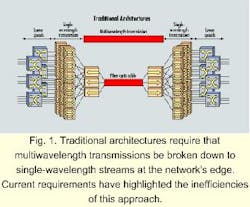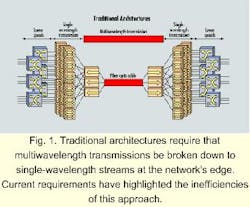Building the multiwavelength core
Two ubiquitous themes have emerged in the telecommunications industry today: unprecedented traffic growth and carrier competition. Exponential growth in data traffic has created a massive revenue opportunity for communications service providers. As with any burgeoning market opportunity, not only is this growth a boon to traditional carriers, but it has attracted a host of new, data-centric carriers eager to stake a claim in the market with competitive service offerings.
This combination of market dynamics is forcing all market participants to formulate new business and operational strategies to address the opportunity. One thing is clear: Traditional network and business models are no longer tenable. Conventional network architectures can no longer scale to match the needs of customers, and current business models can no longer address the increasingly competitive nature of the service-provider market.
As part of their new strategies, carriers are building optical core networks that must reconcile two disparate models: the traditional optical core, populated by a high level of voice traffic, and the broadband data-centric optical core. Both types of networks are under pressure to scale and optimize, though in different ways.
The first model represents the traditional Synchronous Optical Network/Synchronous Digital Hierarchy (sonet/ sdh) ring networks many carriers built to accommodate the high percentage of voice traffic in their networks.
Generally, carriers select ring-based architectures for three reasons:
- Rapid restoration of optical capacity in the event of failure.
- Deterministic restoration, i.e., restoration independent of the number of connections traversing the ring. This restoration simplified the engineering of rings-a critical goal in the scaling, provisioning. and protection of large networks.
- Service granularity, as sonet/sdh add/drop multiplexers (ADMs) also support a range of tributary capacities, allowing carriers to deliver optical bandwidth from OC-48 (2.5 Gbits/sec) to OC-3 (155 Mbits/sec), even when running OC-192 (10 Gbits/sec) across the long-haul network.
As Internet-driven data traffic has grown sharply, network capacity has been at a premium. The immediate solution to boosting fiber capacity was dense wavelength-division multiplexing (DWDM). But while DWDM relieved acute fiber exhaustion, it also left many traditional supporting equipment vendors scrambling to catch up. In long-haul networks, DWDM is typically implemented as a point-to-point solution. To construct a network using DWDM equipment, a carrier must interconnect the point-to-point high-capacity links and manage all traffic flowing through them. Again, a critical component has been the SONET ADM, but since ADMs can each only handle one wavelength of traffic, ADMs proliferate geometrically in a multiwavelength transport system; for example, in a 40-channel DWDM system, each link must terminate into 40 individual ADMs (see Fig. 1).
Of course, if switching of this traffic is required, individual digital-crossconnect systems must also be added to each ADM. The space and power requirements of this equipment mix often create upwardly spiraling operational costs. Furthermore, as the number of DWDM channels and links increases, network management grows more complex, making service provisioning even more cumbersome. This problem can be thought of as the "single-wavelength disconnect": Even though DWDM enables multiwavelength transmission across the carriers' network, a SONET ADM-based infrastructure still requires conversion to single-wavelength systems for capacity management.As carriers look for solutions to simplify their traditional core networks while scaling to meet capacity requirements, many are considering multiwavelength rings. Key to the notion of multiwavelength rings is a new class of network element-a system with both the scale and networking intelligence to support many high-capacity rings. Such a system would extend the benefits of sonet/sdh rings but leave behind the limitations of single-wavelength ADMs; thus, a single network element could terminate multiple logical rings rather than just one (see Fig. 2). Additionally, each logical ring should consist of multiple wavelengths, any of which may interwork. The benefit would be simplified management and planning of the optical core, plus elimination of the "stranded capacity" plaguing "stacked" single-wavelength rings built on traditional ADMs.
A handful of new vendors emerging in the second half of 1999 are working to deliver multiwavelength switching. These architectures offer scalable solutions to interconnect rings and crossconnect high-bandwidth traffic, while dramatically reducing network complexity and the power/space requirements of yesterday's ADMs. To be truly effective, these devices must terminate high-bandwidth connections and switch the entire range of traffic running through the carriers' network-from wavelengths down to the STS-1 (52-Mbit/sec) level. This setup switching granularity simplifies the core network, obviating the need for costly stand-alone network elements (ADMs, digital crossconnects, etc.). The combined scalability and granularity allows the high-bandwidth demands of the core network to coexist with the service demands of traditional telco customers.
Some of these new products also offer networking intelligence features such as the Optical Signaling and Routing Protocol (OSRP) that create an additional layer of value for carriers. Using OSRP, multiwavelength switches in a network can communicate with one another, making them "network aware" and able to perform functions like automatic end-to-end provisioning and rapid mesh restoration. Networking intelligence promises to reduce overall network complexity and cost, while improving service and reliability.
In the second model, the broadband data-centric core, the key driver is lowest cost of network ownership but not at the expense of service or reliability. This constant tension between service levels and operational costs results in a relentless drive toward bandwidth efficiency.
In today's typical ring-based architectures, bandwidth efficiency is a big bone of contention. In a typical 4-fiber bidirectional line-switched ring, 50% of potential bandwidth is designated for protection. This does not imply that the protection channels must remain idle. Indeed, these channels can be used to carry low-priority data traffic. The key issue is that carriers cannot exploit the full revenue potential of that extra traffic because of its inherent lack of protection. Thus, rings are seldom offered; for data-centric carriers, this is simply not an efficient use of bandwidth.
It has long been held that mesh architectures are more bandwidth efficient for data networks. By offering several diverse paths for network restoration in the event of failure, mesh architectures can offer survivability similar to rings without dedicated protection bandwidth. Data-centric carriers might expect to see as much as a 50% increase in effective bandwidth by employing mesh architectures instead of rings over the same fiber plant.
If meshes are so superior to rings, why haven't they become the de facto standard in today's networks? Unfortunately, until recently, technology has not been able to deliver the promise of the theory. In practice, because meshes inherently add diverse paths, network planning and engineering become extremely complex-particularly relative to rings, where protection is automatically added whenever working capacity is added. Fault restoration in mesh networks depends on the switching capacity of digital crossconnects, which have been too slow to meet subsecond voice switch restoration requirements. Mesh network provisioning can also be problematic, as carriers must route circuits through the maze of network elements in a largely manual process.
When data was a small percentage of the network, data bandwidth inefficiency was tolerable. Thus, running data over ring infrastructures was a wise decision-better than building a separate optical network. But when data comprises the majority of network traffic, the inefficiency is too costly.
Moreover, the size of data circuits has begun to swamp large portions of the core. Whereas voice traffic fundamentally travels at the DS-0 (64-kbit/sec) level, this is not so for data. As routers send OC-12c to OC-48c data streams directly through the network, entire rings are quickly consumed. Terabit routers boasting OC-192 capacity are looming. Thus, the growing size of data streams, added to the aggregate data traffic volume, has forced a redesign in the data-centric core.
The same multiwavelength switches that solve traditional core problems can also provide the data-centric core with an effective mesh-based solution. Advancements in processor technology and management software allow these switches to deliver subsecond restoration. Add intelligence, and the complexity of mesh networks is substantially reduced. By communicating with each other, each switch in the mesh becomes "network aware," allowing predetermination of fault restoration paths and real-time end-to-end provisioning, without manual intervention. The result: an extremely resilient, responsive, and scalable network that uses bandwidth as efficiently as possible.
While this article has drawn an arbitrary line between traditional and data-centric carriers, the gap between the two worlds is narrowing. In reality, carrier needs and the reality of network traffic growth have forced most providers to play in both worlds as they seek comprehensive service offerings for their constituents. Traditional carriers have experienced the traffic shift from voice-dominated to data-dominated and had to scale their networks to adjust to that shift. Similarly, data-centric players have found that while data services may be their central focus, ample opportunity exists to offer traditional services as well-making them re-examine the benefits of integrating rings into their networks.
A primary enabler for convergence of these two network types is the multiwavelength switch. To provide comprehensive services to leverage the best of ring and mesh architectures, carriers need a switch with the hardware capability and networking intelligence to support both. Multiwavelength switches decouple service breadth from network complexity and cost, allowing carriers to simplify their networks while increasing their range of potential services at manageable cost.
As carriers rise to the challenge of today's customer needs, scalability, flexibility, and network intelligence will be critical to their success. DWDM solved the critical capacity problem, but the next step lies in harnessing that capacity for the purpose of revenue generation. The advent of multiwavelength switching provides the missing link that will allow carriers to exploit their bandwidth to its maximum potential. u
Rick Dodd is director of product management of the Core Switching Div. of CIENA Corp. (Linthicum, MD).
By Martin Wischhusen, Hewlett-Packard Co.
In the quest for greater scale and lower cost, carriers are asking system vendors for step-function increases in the port density of network elements. To meet this requirement, CIENA leveraged two key technologies in the delivery of its new MultiWave CoreDirector optical-core switch: compact optoelectronics and high-density, high-functionality application-specific integrated circuits (ASICs).
The physical size of optoelectronic components has a direct impact on a system's total density. For OC-48/STM-16 short-haul applications, the optical switch uses the Hewlett-Packard 2.488-Gbit/sec fiber transceiver. This is a short-reach SC duplex module with transmitter, receiver, optical-to-electrical conversion, and other functions such as clock-and-data recovery in one compact module that requires approximately 25% of the power used by some competing solutions.
CIENA complements such advanced optoelectronics with a number of unique ASIC features to maximize the switch's density, scalability, granularity, and functionality. For example, the company's WaveLogic ASIC technology supports any-to-any switching across a range of capacities, from wavelengths down to STS-1s. WaveLogic technology also enables the CoreDirector to grow from 640-Gbit/sec bidirectional switching in one bay to a multiterabit, multibay system.
Optical switches must provide high-density switching, a small footprint, and power/thermal parameters consistent with carrier operating environments if they are to meet the requirements of future multiwavelength core networks. Functional integration-for example, the inclusion of add/drop multiplexers, digital crossconnect, and optical-crossconnect functions in the same system-will likely be another important feature as service providers look to reduce the cost and complexity of their networks. The use of compact optoelectronics and ASICs will prove to be essential techniques for achieving these goals.
Martin Wischhusen is business planning manager, Fiber Optic Communications Div., at Hewlett-Packard Co. (San Jose, CA).


